The Checker Maven
The Death of Expertise
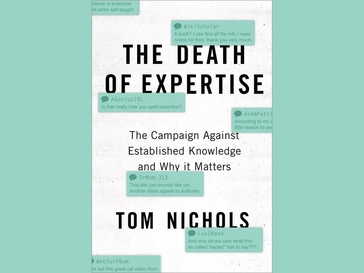
The Death of Expertise, by Tom Nichols, is a book that attempts to make a case for, well, expertise. The author's main points are that in the internet age, everyone thinks they're an expert, and the democratic concept of equality has come to mean that everyone's opinion is equally valid. Mr. Nichols makes a few good points, but then he says this:
"Sensible differences of opinion deteriorate into a bad high school debate in which the objective is to win and facts are deployed like checkers on a board--- none of this rises to the level of chess--- mostly to knock out other facts."
Mr. Nichols' expertise certainly doesn't extend as far as knowing much about checkers, but that doesn't stop him from making a judgment, and thereby becoming guilty of exactly the sort of thing he condemns.
In checkers, expertise comes to the fore. You have it or you don't and there's no faking or pretending. Take, for instance, the following problem, which will require genuine expertise to solve.
WHITE
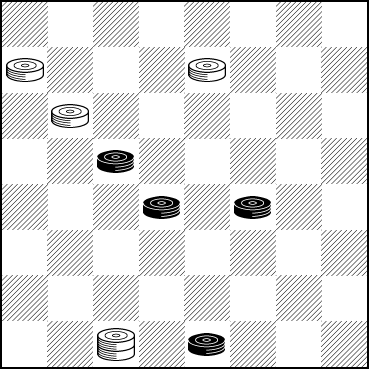
BLACK
Black to Play and Draw
B:WK3,24,26,28:B2,14,15,19.
We think this one will really challenge you. Black has the narrowest of draws and must make a long series of star moves (nine by our count). Rise to the level of checkers (not chess), show your stuff, and do your best on this one. Then check your expertise by clicking on Read More to see the solution.
If you haven't yet reached the expert level, though, don't worry. Working on the problem will in and of itself help you develop, even if in the end you don't find the solution.![]()
Goldilocks
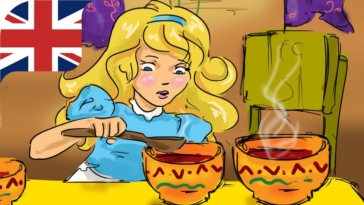
We all know the story of Goldilocks and the Three Bears. There were the porridges that were too hot, and too cold, and just right. There were the chairs that were too big, and too little, and just right. And there were the beds that were too hard, and too soft, and just right.
Brian Hinkle has sent us a checker problem that he calls Goldilocks, because it requires just the right moves at just the right time: not too soon, and not too late.
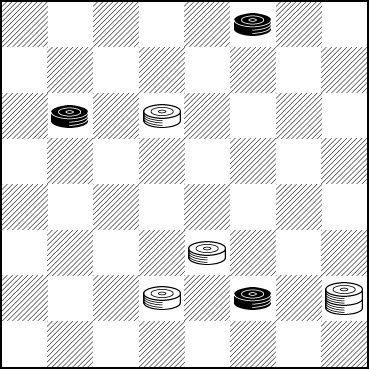
WHITE
White to Play and Win
W:W10,23,26,K28:B3,9,27.
As Brian told us, "White is a man up and has a king, so it should be easy, right?" But of course, it's anything but. This is a master-level problem whose solution eluded many an expert player.
Whatever your skill level, though, this problem rewards careful study and the solution is very pleasing. We know you'll love it when you see it. First, though, do the best you can, and when you've done not too much, and not too little, but just the right amount of study--- be sure to click on Read More to see the solution.![]()
Gibson

Yes, that's a Gibson Les Paul guitar, made by the Gibson company. The famous guitar manufacturer was founded by one Orville Gibson in 1902, and revolutionized guitar design with an arch-top model, based on the design of the violin.
Our current Checker School series is featuring "snappy" problems by G. M. Gibson. We don't know anything about this gentleman; was he a contemporary of Orville, or a relative or descendant? Did Orville play checkers himself?
These questions will remain unanswered for the moment. But we're happy to present another of Mr. Gibson's "snappy" (or should we, to accord with our metaphor, call it "twangy"?) problems.
WHITE
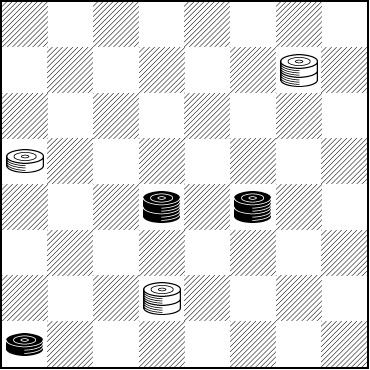
BLACK
B:WK7,20,K25:B4,K14,K15.
Forces are even, although Black, with centralized kings, may have more mobility. Can you snap out a win from this one? Pick away at it and then strum your mouse on Read More to see the solution.![]()
Clever, Clever

Clever, Montana, is a real place, a fast-growing small town of about 3,000 with the motto "It just gets better every day." The town is well over 100 years old and it's pretty likely to have some sort of checker playing history. Do folks still play checkers in Clever? We emailed a town official but we never got a reply, so we can't say for sure.
There's certainly a place for cleverness in the game of checkers, and today's problem, a "not quite" speed problem, relies on a clever first move.
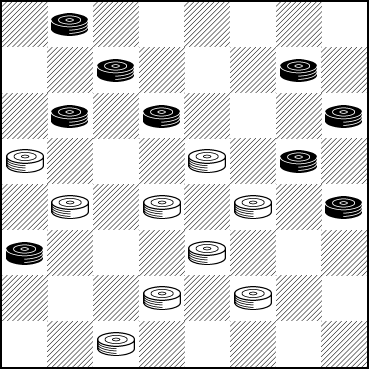
WHITE
White to Play and Draw
W:W13,15,17,18,19,23,26,27,30:B1,6,8,9,10,12,16,20,21.
Are you clever enough to solve it? We think you are, but when you're done, the clever thing to do would be to click on Read More to check your solution.![]()
Labor Day 2018

Labor Day is another one of our favorite holidays, for it gives us the chance to recognize the contributions of the average guy and gal, the working woman and working man who are the backbone of America's prosperity. Every day these folks put in an honest day's work and ask no more than the chance to get ahead a little, to take care of their families, and to do their part in building a society that will offer something to everyone.
As we've pointed out in previous years, many checkerists were and are "ordinary" people who in fact are quite extraordinary. Checker champions have been baseball players and steel workers and just about anything you can think of. Checkers knows no boundary of class or status, and we can't help but feel good about that.
We turn as always to Tom Wiswell, with something he called Fantastic. He could have easily been describing himself, but of course Mr. Wiswell was modest and humble as are most of the truly great.
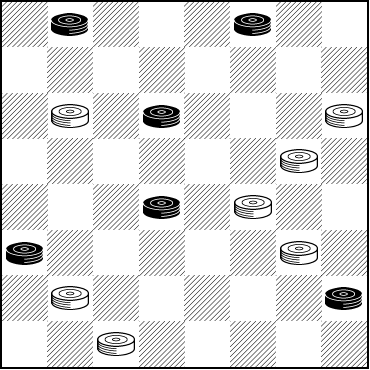
WHITE
White to Play and Win?
W:W9,12,16,19,24,25,30:B1,3,10,18,21,28.
Now, we're going to do something different this week. We'll give you the solution up front. Here is what Mr. Wiswell published quite some years ago.
| 1. | ... | 19-15 |
| 2. | 10x19 | 24x15 |
| 3. | 28-32 | 15-10 |
| 4. | 32-27 | 9-6 |
| 5. | 18-23 | 6-2 |
| 6. | 23-26 | 30x23 |
| 7. | 27x18 | 2-7 |
| 8. | 21x30 | 12-8 |
| 9. | 3x19 | 10-6 |
Mr. Wiswell's solution ends here. Continue:
| 10. | 1x10 | 7x16 |
White Wins with the opposition.
But the thing is that Mr. Wiswell, very uncharacteristically, was wrong. The position is actually a draw. So what you ask you to labor away at is this: Correct the play above and show how Black can draw. You've got your work cut out for you, and the task is not easy. But, as the saying goes, that's why they call it "work." When you're ready, work your mouse over to Read More to see the annotated and corrected play.![]()
